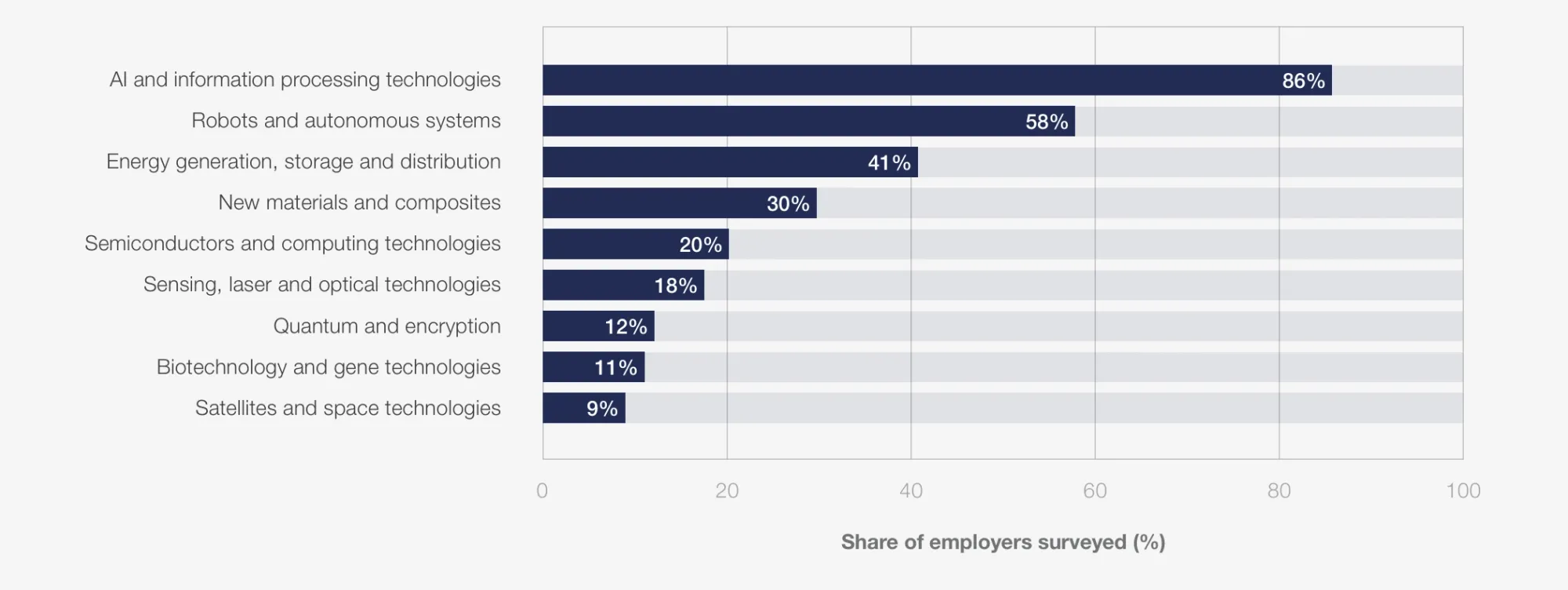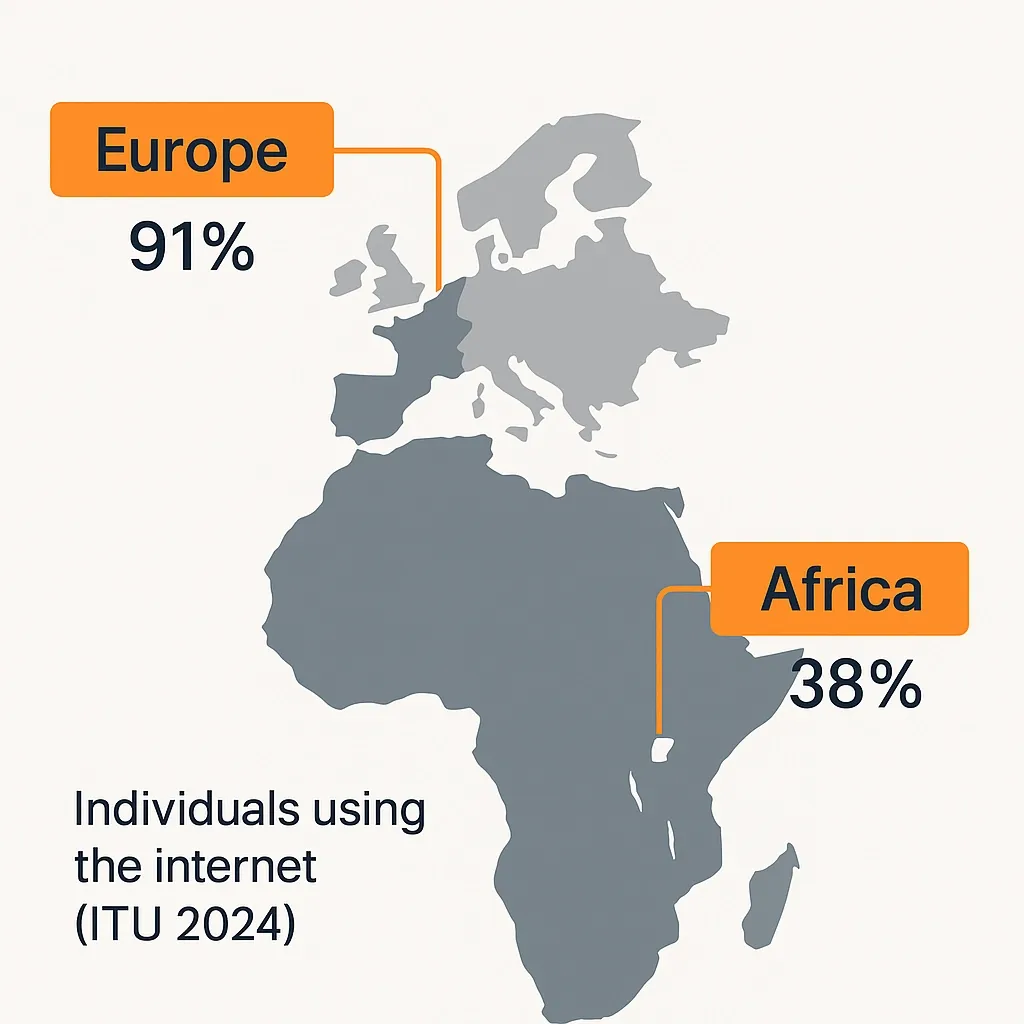If the future of work were a film, the robots and large language models would hog the trailer while your frontline staff carry the plot. The credits are rolling in. Time to decide who gets a sequel and who exits stage left.
Debate over the last year has fixated on generative AI in white‑collar roles. Meanwhile, the real labour‑market shake‑up is broader and messier. The World Economic Forum’s Jobs of Tomorrow: Technology and the Future of the World’s Largest Workforces identifies four technology forces that will recode work across seven job families that employ billions: agriculture, manufacturing, construction, retail and wholesale, transport and logistics, business and management, and healthcare.
The catch is obvious. Benefits and risks will not be evenly distributed, especially across income levels and industry mixes. Leaders who wait for clarity will inherit someone else’s future.
Momentum isn’t always progress, especially when you always end up back where you started.
Fathom helps you escape the loop. With insight, not intuition.
This article translates WEF’s cross‑industry brief into an operating plan. We combine Jobs of Tomorrow with WEF’s Future of Jobs 2025, plus Gallup, Deloitte, Randstad, Mercer and Korn Ferry, to convert trends into choices you can make this quarter. Where possible we point to the specific tables and charts you will want your team to scrutinise.
The four tech forces you cannot ignore
1) Artificial intelligence
AI, including genAI and agentic systems, is the most widely expected disruptor. In the WEF survey, 86 percent of employers expect AI and information processing to transform their business by 2030. See Figure 1.2 in Future of Jobs 2025.
AI augments everything from maintenance and fraud prevention to complex decision support. The white paper stresses AI’s promise for productivity alongside risks in privacy, reliability and value capture, especially as agentic systems arrive.

2) Robotics and autonomous systems
Physical AI is moving out of the lab. Robot installations have grown 5 to 7 percent annually since 2020, with 80 percent of installs concentrated in China, Japan, the US, Korea and Germany. The WEF notes an estimated 40 percent cost reduction in the last two years, accelerating adoption in high‑volume manufacturing and logistics.
3) Energy technology
From generation to storage to distribution, energy tech is expected to transform 41 percent of organisations by 2030, changing job types and skill demand as EVs scale and data centres sip power like marathoners.
4) Networks and sensing
Connectivity and sensing are the substrate for everything else. Today’s access gap is enormous: 91 percent Internet access in Europe vs 38 percent in Africa. Whether this gap narrows will determine if tech lifts productivity everywhere or just in already connected economies. Advances in LiDAR, cameras and tactile sensors make physical automation safer and smarter across worksites.
Helping HR, talent acquisition, employer branding, and company culture professionals find careers worth smiling about.
The seven workforces that will feel it first
WEF’s paper focuses on where people actually work today, not just in shiny new job ads. Here is what to plan for, sector by sector.
- Agriculture
Precision agriculture will run on drones, sensors and AI‑guided inputs. Network coverage is your rate limiter. Expect roles to shift from manual cultivation to tech‑enabled operations and maintenance, plus data‑guided agronomy. Invest in rural connectivity partnerships and technician apprenticeships before you procure equipment. - Manufacturing
With robot costs falling and installs concentrated in five economies, late adopters risk widening productivity gaps. Rebalance job architectures toward robot programming, line reconfiguration and quality analytics. Standard safety and reskilling protocols should precede any retrofit. - Construction
Autonomous equipment, drones and digital twins will reduce rework and improve safety. The constraint is skills transfer to site managers who can orchestrate tech and trades. Tie foreman development to sensor data literacy and change‑order analytics. - Wholesale and retail
Computer vision, robotics and AI will take on inventory, planograms and service triage. Frontline roles shift to exception handling and customer advocacy. Retailers should redesign incentives toward multi‑skilling and service resolution, not only shrinkage and speed. - Transport and logistics
Autonomous systems, route optimisation and warehouse robotics are becoming standard. Growth will concentrate in network‑dense regions, so plan for place‑based talent strategies that match your nodes. - Business and management
AI will rewrite meeting notes, draft routine comms and surface insights. The value moves to judgement, relationship building and cross‑system orchestration. Leaders need new norms for “AI‑ready” workflows and evidence standards. - Healthcare
Sensing, diagnostics and AI triage can reduce bottlenecks while increasing demand for human‑centred care. Expect growth in nursing and allied health with augmentation rather than replacement.
The labour‑market math you should run before Q3
- Net job effect looks positive on current trends. WEF projects 170 million jobs created and 92 million displaced by 2030, a net 7 percent increase or 78 million jobs. See Future of Jobs 2025 key findings.
- The biggest absolute growth will be in frontline roles such as farmworkers, delivery drivers, construction workers, sales and food processing. The fastest percentage growth sits in tech, green jobs and energy transition roles. Clerical roles see the steepest declines. See Chapter 2 for the growth and decline lists.
- Skill instability slows but stays high. About 39 percent of workers’ skills will change by 2030. 59 of 100 workers need training, but employers expect 11 of 100 to miss out entirely. Upskilling remains the top employer response at 85 percent planning to prioritise it. Health and wellbeing tops talent attraction levers at 64 percent.
- Engagement is wobbling exactly when reinvention needs it most. Gallup reports global engagement fell from 23 to 21 percent in 2024, a loss worth US$438 billion. The driver is managers, whose engagement dropped from 30 to 27 percent. Managers account for 70 percent of team engagement variance. See charts on pages 6 to 8.
Translation: you are not short of jobs or tools. You are short of systems that move skills, protect attention, and keep managers capable and sane.
Operating instructions for the new work order
A. Stop chasing headlines. Fix your capacity problem.
Deloitte’s 2025 Trends calls out a simple truth. Work is being slowed by work. Leaders need “stagility” to give workers enough stability to master change at speed. That means creating slack on purpose, trimming low‑value tasks, and focusing capacity on outcomes instead of outputs. Only 6 percent of organisations say they are making great progress on human sustainability, which tells you how far there is to go. See Figure 1 in the report for the tensions to balance.
Move: Run a “work reset”. Catalogue tasks by value, automate the junk, and bank the saved capacity into learning, experimentation and cross‑functional sprints. Then protect it.
B. Treat AI as a teammate, not an overlord
The hype cycle is maturing. Korn Ferry finds 67 percent of TA leaders say more AI usage will be 2025’s top trend, but 40 percent worry that too much AI makes hiring impersonal and risks missing quality candidates. For channel shifts and TA implications, see LinkedIn’s Future of Recruiting 2025. The near‑term wins are chore automation and decision support, not judgement outsourcing.
Move: Define your “AI‑ready workflow” standard. For every process, specify what AI drafts, what humans decide, what evidence is required, and how bias and accuracy are monitored. Then train people to that standard.
C. Put skills and mobility in the compensation conversation
WEF shows demand rising for AI and big data, networks and cybersecurity, and technology literacy, alongside creative thinking and resilience. The same report notes over half of employers expect to allocate a larger revenue share to wages by 2030. This is your prompt to tie pay progression to verified skills and internal mobility, not only time served.
Move: Build a verified skills graph and introduce pay accelerators for hard‑to‑find capabilities. Randstad’s 2025 research shows strong executive appetite for skills, internal mobility and HR tech, with 82 percent positive on AI and automation, and 75 percent excited about internal mobility. Also note the “pixelation of work” trend: deploy people to tasks, not only jobs. For the bigger pattern behind skills and mobility, read The Talent Multiverse.
Momentum isn’t always progress, especially when you always end up back where you started.
Fathom helps you escape the loop. With insight, not intuition.
D. Repair the manager spine
The best AI pilot will not survive a disengaged manager. Gallup’s data shows the global drop in engagement is largely a manager story. Older and female managers took the biggest wellbeing hit, and when managers slide, teams follow. Rebuild expectations, scope, tools and time. Then teach managers how to run AI‑augmented teams that are human by default.
Move: Narrow spans where needed, remove administrative busywork, and equip managers with coaching routines tied to skill growth. Then measure manager engagement as a first‑order KPI.
E. Close the experience gap you accidentally widened
As AI eats entry‑level tasks, it also erodes the practice ground where people learn. Deloitte calls out an emerging “experience gap” that makes new hires less ready to contribute. Answer with structured practice: simulations, projects, and rotations.
Move: Build apprenticeship‑style pathways that use AI to scaffold learning while protecting time for human mentoring. Track readiness through demonstrations, not only certificates.
F. Don’t ignore place
Networks and sensing are not evenly distributed. The Internet access gap between Europe and Africa is stark. If your supply chain or growth bets depend on connected work, budget for connectivity and local skilling or assume slower productivity catch‑up outside rich networks.

Move: Co‑invest in connectivity with local partners. Pair it with technician training in robotics and energy systems to avoid stranded assets.
G. Update your EVP for an AI world
Deloitte advises rewriting the employee value proposition for human plus machine. For a practical take on what to change, see why your EVP needs an AI upgrade. People need clarity on how AI affects roles, careers and wellbeing. Without it, adoption lags and trust leaks.
Move: Publish your AI principles, learning entitlements, and career ladders that reflect augmentation. Tie performance to learning velocity and cross‑domain collaboration.
Counterarguments and what to do with them
- “We will wait until the tech is proven.” Sensible, in theory. In practice, delay compounds inequality between firms and regions. Robot costs are already down and concentrated in the most competitive economies. Do a controlled rollout with gating criteria rather than a blanket pause.
- “Upskilling is expensive.” So is churn and under‑utilised equipment. WEF estimates that a majority of workers need training and that employers already plan to prioritise it. Build pooled budgets with business units and measure payback in throughput and defect reduction, not only course completions.
- “Managers are overwhelmed.” Correct. Which is why you redesign the role. Narrow scope, automate busywork and provide coaching time. Gallup’s data shows the ROI runs through the manager.
Actionable insights you can start this quarter
- Name your top ten automations by job family and commit to augmentation‑first design. Publish what AI does and what humans own. Owner: COO with CHRO.
- Launch a 90‑day work reset. Remove two low‑value processes per function. Ring‑fence recovered hours for learning and service improvements. Owner: CEO staff with Finance.
- Stand up a skills graph that maps today’s workforce to tomorrow’s roles. Tie pay progression to verified skills and mobility. Owner: CHRO with CIO.
- Rewrite the EVP for AI. Include principles, training rights, and safety guardrails. Owner: CHRO with Legal and Comms. For brand implications, read what it means for employer branding.
- Rebuild the manager role with clear time for coaching and fewer direct reports in complex contexts. Track manager engagement monthly. Owner: CHRO.
- Plan for place. For operations in low‑connectivity regions, co‑invest in networks and local technician training before equipment spend. Owner: COO with CSR.
- Prepare frontline growth. The biggest absolute job gains will be in frontline work. Build pipelines and career ladders that move people from frontline to tech‑adjacent roles. Owner: Talent Acquisition with Business Leaders.
Conclusion
The story the data tells is not dystopian. It is demanding. AI, robotics, energy and sensing will raise the productivity ceiling. Whether that translates into good jobs and resilient businesses depends on the unglamorous choices leaders make now. Focus on capacity, managers, skills and connectivity and you can turn the next five years into a case study rather than a cautionary tale. As ever, the future turns up for those who did the homework.
Workforce Playmaker
Not another report recap. This Playmaker turns WEF’s 2025 outlook (plus Gallup, Deloitte, Mercer, Korn Ferry and Randstad) into three concrete plays for your context: pick your workforce, region and readiness, then hit Generate.

Workforce Playmaker
Data sources
- World Economic Forum — The Future of Jobs Report 2025 (overview) · PDF
- World Economic Forum — Jobs of Tomorrow: Technology and the Future of the World’s Largest Workforces (2025) · PDF
- Gallup — State of the Global Workplace 2025 (PDF)
- Deloitte — Global Human Capital Trends 2025
- Randstad Enterprise — 2025 Global Talent Trends
- Korn Ferry — Talent Acquisition Trends 2025
- Mercer — Global Talent Trends 2024–2025
Takeaways
1) What is the single most important stat in WEF’s 2025 outlook?
Eighty six percent of employers expect AI to transform their business by 2030. Plan for augmentation at scale, not isolated pilots. See Figure 1.2.
2) Where will jobs actually grow?
Frontline roles grow most in absolute numbers, while tech and green jobs grow fastest by percentage. Clerical roles decline sharply. Rebuild pipelines accordingly.
3) How big is the reskilling gap?
Fifty nine out of 100 workers need training by 2030. Employers think 11 will miss out entirely without intervention. Upskilling plans are widespread at 85 percent of firms.
4) Why is my transformation stalling even with strong tech?
Because manager engagement is dropping. It fell from 30 to 27 percent, dragging teams and productivity with it. Fix the manager experience.
5) Should we pause AI in hiring to avoid bias and bad candidate experience?
Do not pause. Do govern. Korn Ferry shows leaders are wary of impersonal experiences, yet most plan more AI. Define guardrails and keep humans in the loop.
6) What organisational idea best captures the moment?
“Stagility.” Create stable ground for people inside a fast‑moving organisation. Use a work reset to free capacity and spend it on learning and innovation.
7) What if our growth markets lack connectivity?
Plan for it explicitly. The Internet access gap is severe. Co‑invest in networks and local training or expect adoption to lag and ROI to underwhelm.
Sources referenced
- World Economic Forum — Jobs of Tomorrow: Technology and the Future of the World’s Largest Workforces (Oct 2025)
Web page: https://www.weforum.org/publications/jobs-of-tomorrow-technology-and-the-future-of-the-world-s-largest-workforces/
PDF: https://reports.weforum.org/docs/WEF_Jobs_of_Tomorrow_Technology_and_the_Future_of_the_Worlds_Largest_Workforces_2025.pdf - World Economic Forum — The Future of Jobs Report 2025
Overview/digest: https://www.weforum.org/publications/the-future-of-jobs-report-2025/digest/
PDF: https://www3.weforum.org/docs/WEF_Future_of_Jobs_Report_2025.pdf - Gallup — State of the Global Workplace 2025
Executive summary PDF: https://www.gallup.com/file/workplace/659528/state-of-the-global-workplace-2025-download.pdf
Related Gallup article referencing 2025 findings: https://news.gallup.com/topic/workplace.aspx - Deloitte — 2025 Global Human Capital Trends
Report hub: https://www.deloitte.com/us/en/insights/topics/talent/human-capital-trends.html - Randstad Enterprise — 2025 Global Talent Trends
Report hub: https://www.randstadenterprise.com/talent-trends/ - Korn Ferry — Talent Trends 2025: Progress Over Perfection
Report landing page: https://www.kornferry.com/insights/featured-topics/talent-recruitment/talent-acquisition-trends-2025
Press release: https://www.kornferry.com/about-us/press/korn-ferry-research-reveals-top-talent-acquisition-trends-shaping-2025 - Mercer — HR 2025
Global Talent Trends 2024–2025 hub: https://www.mercer.com/insights/people-strategy/future-of-work/global-talent-trends/
HR Trends 2025 explainer: https://www.mercer.com/en-au/insights/talent-and-transformation/attracting-and-retaining-talent/hr-trends-2025-embracing-ai-flexibility-and-a-skills-powered-future/






